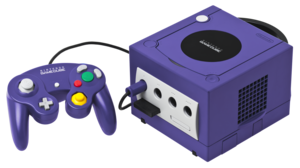GameCube
 |
|

An indigo Nintendo GameCube console with its controller and the 251-block memory card
|
|
| Also known as | Dolphin (code name) |
|---|---|
| Developer | Nintendo |
| Manufacturer |
|
| Type | Home video game console |
| Generation | Sixth generation |
| Release date | |
| Retail availability | 2001–2007 |
| Discontinued | 2007 |
| Units sold |
|
| Media |
|
| Operating system | Dolphin OS |
| CPU | IBM PowerPC Gekko @ 486 MHz |
| Storage | None |
| Removable storage | Nintendo GameCube memory card (16 MB max. capacity) |
| Display |
|
| Graphics | ATI Flipper @ 162 MHz |
| Sound | Analog stereo (Dolby Pro Logic II) |
| Controller input | GameCube controller, WaveBird, Game Boy Advance, various other input devices |
| Connectivity | Nintendo GameCube Broadband Adapter and Modem Adapter |
| Online services | Limited |
| Dimensions | 5.9 × 6.3 × 4.3 in 149 × 160 × 112 mm (width × depth × height) |
| Best-selling game | Super Smash Bros. Melee, 7.09 million (as of March 10, 2008[update]) |
| Predecessor | Nintendo 64 |
| Successor | Wii |
| Related articles | Panasonic Q |
The GameCube (Japanese: ゲームキューブ Hepburn: Gēmukyūbu?, officially called the Nintendo GameCube, abbreviated NGC in Japan and GCN in Europe and North America) is a home video game console released by Nintendo in Japan on September 14, 2001; in North America on November 18, 2001; in Europe on May 3, 2002; and in Australia on May 17, 2002. The sixth-generation console is the successor to the Nintendo 64 and competed with Sony Computer Entertainment's PlayStation 2 and Microsoft's Xbox.
The GameCube is the first Nintendo console to use optical discs as its primary storage medium. The discs are similar to the miniDVD format; as a result of their smaller size and the console's small disc compartment, the system was not designed to play standard DVDs or audio CDs. The console supports online gaming for a small number of titles via the broadband or modem adapter and connects to the Game Boy Advance via the link cable, allowing players to access exclusive in-game features using the handheld as a second screen and controller.
...
Wikipedia
